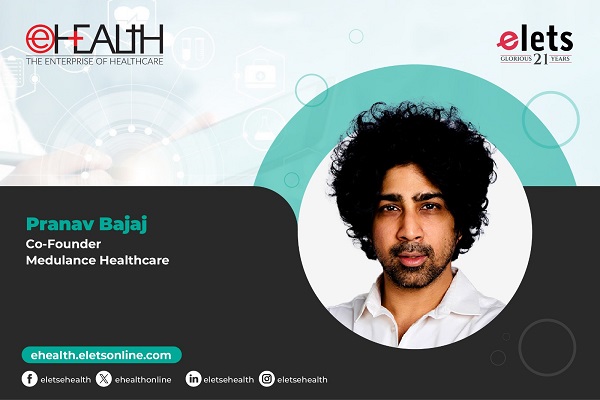
The probability of exposure to infectious agents have increased manifold owing to globalisation and increasing travel opportunities both within and across the countries. Despite the availability of vaccines, many adults remain unvaccinated because they are unaware of the need for adult vaccines or are misinformed about vaccines and the diseases they are designed to prevent, says Dr Rakesh K Chawla, senior consultant, Department of Respiratory Medicine, Jaipur Golden Hospital, Rohini, New Delhi, in conversation with Elets News Network (ENN).
Q What is adult immunisation and how it is relevant today?

 Immunisation is one of the most effective public health interventions, reducing or eliminating the burden of many infectious diseases. The primary focus of vaccination programmes has historically been directed to childhood immunisations. For adults, chronic diseases have been the primary focus of preventive and medical healthcare, though there has been increased emphasis on preventing infectious diseases as well.
Immunisation is one of the most effective public health interventions, reducing or eliminating the burden of many infectious diseases. The primary focus of vaccination programmes has historically been directed to childhood immunisations. For adults, chronic diseases have been the primary focus of preventive and medical healthcare, though there has been increased emphasis on preventing infectious diseases as well.
Adult vaccination coverage, however, remains low for most of the routinely recommended vaccines. Protecting adults through vaccination has never been considered a preventive strategy. Though adults are less susceptible to fall prey to traditional infectious agents, emergence of HIV/AIDS, and re-emergence of malaria and tuberculosis world over has complicated the prevailing fragile health scenario.
Also, the probability of exposure to infectious agents have increased manifold owing to globalisation and increasing travel opportunities both within and across the countries. Despite the availability of vaccines, many adults remain unvaccinated because they are unaware of the need for adult vaccines or are misinformed about vaccines and the diseases they are designed to prevent. Thus, there is an urgent need to address the problem of adult immunisation.

Q Who needs to get Adult Vaccines?
The adult immunisation is complex, encompassing a wide variety of vaccines and a very diverse target population ranging from healthy young adults to young adults and elderly with chronic conditions to those who are less likely to have a medical home and seek medical care in nontraditional settings. This diverse patient population is in turn served by an equally diverse network of healthcare providers.
Additionally, vaccination recommendation for adults span the interface between adolescents and adults (human papilloma virus and meningococcal vaccines), include vaccines that are universally recommended (influenza) as well as those that are recommended for certain age groups (herpes zoster), vaccines targeted to individuals with specific risk factors (hepatitis A and B), travel vaccines (e.g., typhoid, yellow fever, polio), and vaccines targeted to particular combinations of age and risk factors (pneumococcal).
Q Tell us about the global trends on this front?
The burden of vaccine preventable diseases according to world health statistics 2013, in a year, there were 4880 reported cases of diphtheria, 162 047 reported cases of pertussis, 14 272 reported cases of tetanus, 354 820 reported cases of measles, 726 169 reported cases of mumps, and 114 449 reported cases of rubella. Globally, in 2011, there were 2500 deaths due to diphtheria, 4 158 000 measles deaths”about 430 deaths every day or 18 deaths every hour.
Worldwide, annual epidemics of influenza result in about three to five million cases of severe illness, and about 250 000 to 500 000 deaths. Influenza vaccine can prevent 70% to 90% of influenza-specific illness. Among the elderly, the vaccine reduces severe illnesses and complications by up to 60% and deaths by 80%. The Hepatitis A virus has a worldwide distribution and causes about 1.4 million cases of clinical hepatitis each year.
About 600000 people die every year due to the acute or chronic consequences of hepatitis B. Hepatitis B prence is highest in sub-Saharan Africa and East Asia. Most people in these regions become infected with the hepatitis B virus during childhood and between 5“10% of the adult population are chronically infected.
HPV is estimated to cause 100% of cervical cancer cases, 90% of anal cancer cases, 40% of cases of cancers of the external genitalia (vulva, vagina, and penis), at least 12% of oro-pharyngeal cancer cases, and at least 3% of oral cancer cases.9 Cervical cancer is the second most common cancer in women, with an estimated 530 000 new cases every year. Every year, more than 270 000 women die from cervical cancer; more than 85% of these deaths are in low and middle-income countries.
Q Where does India stand in AIP and what are the challenges?
In India there is paucity of epidemiological reliable data regarding the burden of communicable diseases. An expert group also observed that few published data are available from India regarding efficacy and safety of vaccines in adult immunization strategies. Because of scarcity data on communicable diseases and adequacy of immunisation (e.g., optimal antibody titers in adults for preventing various diseases), the Expert Group realized that there is an urgent need for collecting reliable epidemiological data in India on infectious diseases, efficacy, and safety data regarding various adult immunization strategies, and data regarding the adequacy of immunization in adults.
India needs to immediately address the challenge of adult immunisation. Although many issues revolving around efficacy, safety and cost of introducing vaccines for adults at the national level are yet to be resolved, there is an urgent need to sensitise health planners as well as healthcare providers regarding this pertinent issue.
Adult immunisation practices and policies must be framed by the Ministry of Health and Family Welfare, and there need to be intensive efforts for the provision of vaccines in the national immunisation schedule that could help mitigate adult suffering from infectious diseases. Adult vaccination must become part of routine immunization because these vaccines can save millions of lives in India alone.
CHALLENGES:-
The common barrier to immunization in adulthood includes –
- Lack of recognition of the importance of adult immunisation
- Lack of recommendation from healthcare providers
- Lack of knowledge about adult immunization and recommended vaccines to healthcare provider
- Misrepresentation/misunderstanding of the risks of vaccine and benefits of disease prevention in adults
- Lack of understanding of vaccine safety and efficacy
- Missed opportunities for vaccination in healthcare providers offices, hospitals, and nursing homes
- Lack of publicly-funded vaccine and reimbursement to vaccine providers
- Lack of coordinated immunisation programs for adults
- Lack of regulatory or legal requirements
- Fear of injections
- Lack of availability of up-to-date records and recording systems.
Q Do you think people need to make aware about the same?
Substantial improvement in adult vaccination is needed to reduce the health consequences of vaccine-preventable diseases among adults. Healthcare provider recommendations for vaccination are associated with increased uptake of patient vaccination.
It is the responsibility of healthcare providers to routinely access the adult patients vaccination needs, recommendation, and offer of needed vaccines for adults.
Successful vaccination programmes combine:
- Education of potential vaccine recipients and publicity to promote vaccination
- Increased access to vaccination services in medical and complementary settings, such as workplaces and commercial establishments (e.g pharmacies)
- Use of practices shown to improve vaccination coverage, including reminder-recall systems, efforts to remove administrative and financial barriers to vaccination, use of standing order programmes for vaccination and assessment of practice-level vaccination rates with feedback to staff members.
In addition to increasing routine vaccination delivery to adults, development of a comprehensive and sustainable adult immunisation program will improve public health preparedness and emergency response capability (e.g., delivery of medical counter measures, dissemination of information).
Q How pollution poses a big risk for people living in metro cities?
An estimated 1.2 million people died from air pollution in 2015 in India due to ambient particulate matter pollution, according to Global Burden of Diseases. Reports find that the country has recorded a nearly 50 percent increase in early deaths linked to fine airborne particles between 1990 and 2015. Pollution levels in the country have been rising at an alarming rate. Coal consumption almost doubled and oil consumption increased by 60 percent from 2005 to 2015.
A large number of studies in the Metropoliton cities have examined the effect of air pollution on respiratory functions and the associated morbidity. The most comprehensive study among them was the one conducted by the Central Pollution Control Board in 2008, which identified significant associations with all relevant adverse health outcomes.The findings were compared with a rural control population in West Bengal.
It was found that Delhi had 1.7-times higher prence of respiratory symptoms (in the past 3 months) compared with rural controls (P < 0.001); the odds ratio of upper respiratory symptoms in the past 3 months in Delhi was 1.59 (95% CI 1.32-1.91) and for lower respiratory symptoms (dry cough,wheeze, breathlessness, chest discomfort) was 1.67 (95% CI 1.32-1.93).
Prence of current asthma (in the last 12 months) and physician-diagnosed asthma among the participants of Delhi was significantly higher.
Lung function was reduced in 40.3% individuals of Delhi compared with 20.1% in the control group. Delhi showed a statistically significant (P < 0.05) increased prence of restrictive (22.5% vs. 11.4% in control), obstructive (10.7% vs. 6.6%) as well as combined (both obstructive and restrictive) type of lung functions deficits (7.1% vs. 2.0%).
Metaplasia and dysplasia of airway epithelial cells were more frequent in Delhi, and Delhi had the greater prence of several cytological changes in sputum.
Besides these, non-respiratory effects were also seen to be more in Delhi than in rural controls. The prence of hypertension was 36% in Delhi against 9.5% in the controls, which was found to be positively correlated with respirable suspended particulate matter (PM10) level in ambient air. Delhi had significantly higher levels of chronic headache, eye irritation and skin irritation. Several other community-based studies have found that air pollution is associated withrespiratory morbidity.
Studies that have examined the compounding effect of meteorological conditions on air pollution found that winter worsened the air quality of both indoor air and outdoor air. They also found a positive correlation between the winter weather and rise in the number of patients with chronic obstructive airway disease in hospitals.
There was a relative paucity of studies that measured outdoor air pollutant levels first hand and then tried to objectively correlate them to adverse health effects. However, some studies measured air pollutant levels and found a correlation with health-related events.
A time-series study on air pollution and mortality from Delhi found that all-natural-cause mortality increased with increased air pollution.
In another study, gaseous pollutants, in spite of being at a level lower than the permissible level, showed more consistent association with respiratory admissions.In a hospital-based study, an increase in emergency room visits for asthma, chronic obstructive airway disease and acute coronary events was reported with an increase in air pollutant levels.
Q What preventive measures could be taken to protect themselves from the harmful effect of pollutants?
Air pollution is highest during the heat of the day, so plan your outdoor activities for early morning or late evening. Avoid walking or biking on busy streets. If you’re sitting in traffic, use the recycled air setting on your air conditioner to help cut down on fumes.
If you’re in a location where you can’t escape the pollution, try putting a handkerchief over your mouth and nose to help filter gas and smoke.
Antioxidant-rich foods like fruits and vegetables can also help shield your body from the damaging effects of free radicals created by air pollution.
Finally, don’t forget that indoor spaces can be polluted, too. To limit pollution in the home, follow these recommendations:
- Consider purchasing an indoor air purifier.
- Avoid air fresheners and candles.
- Keep filters on air conditioners and heaters clean.
- Vacuum often.
- Wash sheets and stuffed toys to get rid of dust mites.
- Wash mold and mildew off hard surfaces.
- Open the windows to circulate the air on days when the air quality is good.
With a little extra effort, you and your family can breathe cleaner air and enjoy better health.
Be a part of Elets Collaborative Initiatives. Join Us for Upcoming Events and explore business opportunities. Like us on Facebook , connect with us on LinkedIn and follow us on Twitter , Instagram.












